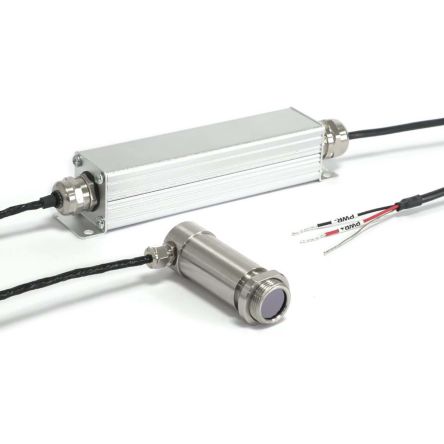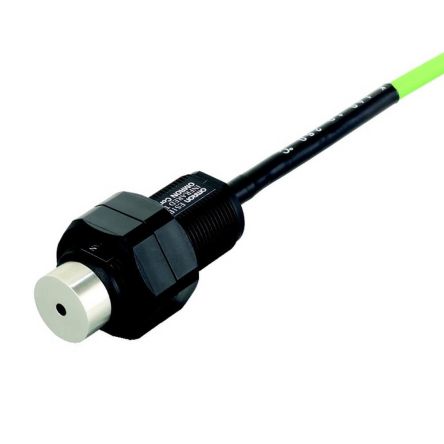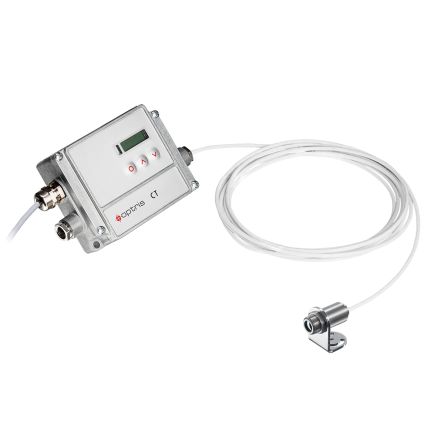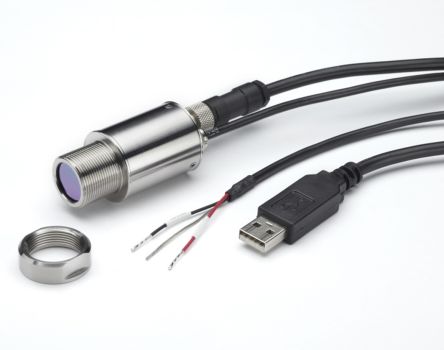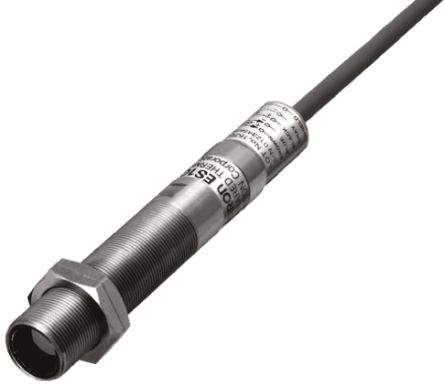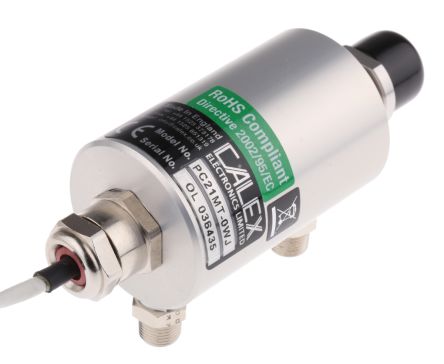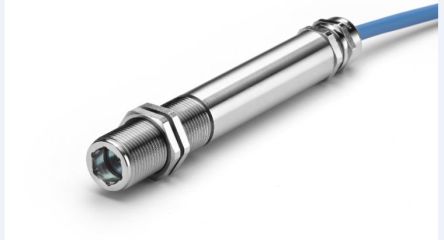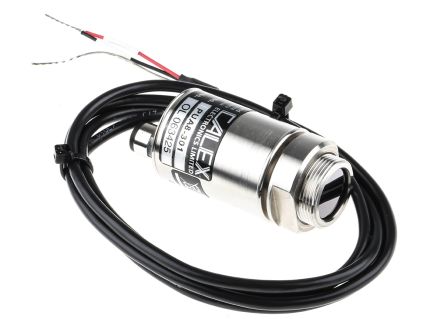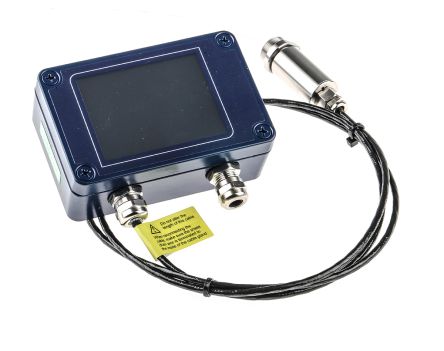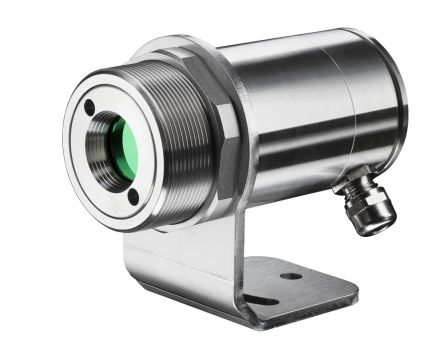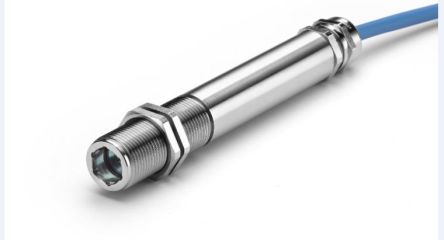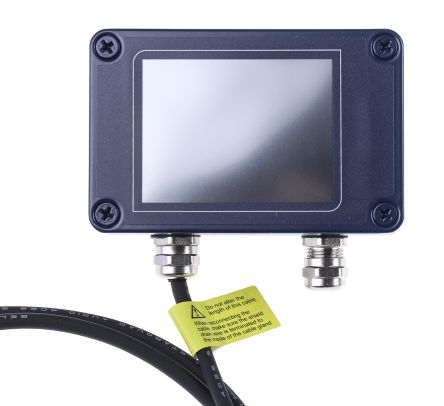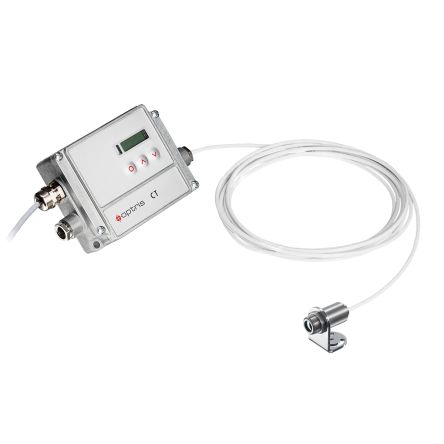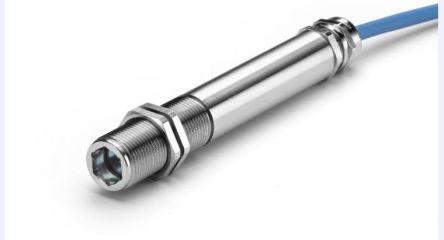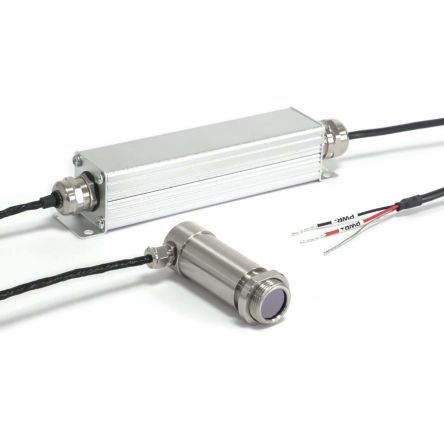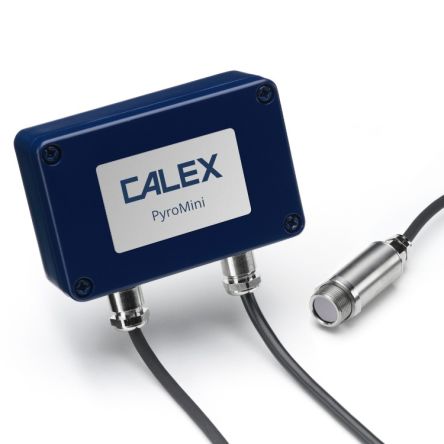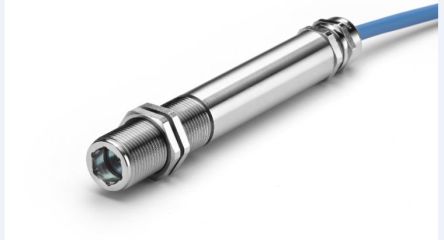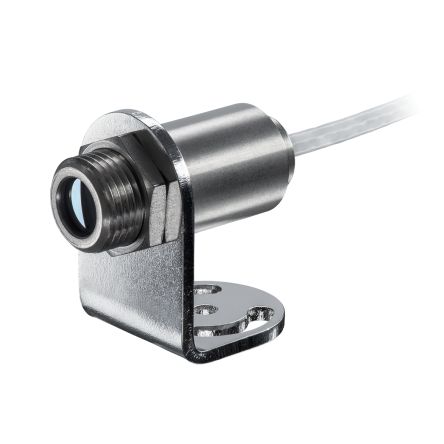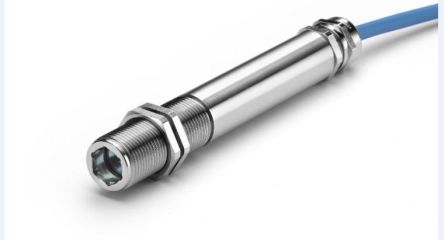- Automation & Control Gear
- Cables & Wires
- Enclosures & Server Racks
- Fuses & Circuit Breakers
- HVAC, Fans & Thermal Management
- Lighting
- Relays & Signal Conditioning
- Switches
- Batteries & Chargers
- Connectors
- Displays & Optoelectronics
- ESD Control, Cleanroom & PCB Prototyping
- Passive Components
- Power Supplies & Transformers
- Raspberry Pi, Arduino, ROCK, STEM Education & Development Tools
- Semiconductors
Infrared Temperature Sensors
Infrared temperature sensors, also known as IR temperature sensors or contactless temperature sensors, are essential tools for non-contact temperature measurement across various industries. They measure temperature by detecting emitted infrared radiation. This makes them essential in industries where traditional contact-based temperature probes cannot be used, such as measuring moving objects, extremely hot surfaces or objects in hazardous environments.
What Are Infrared Temperature Sensors?
Infrared temperature sensors, also known as IR sensors or infrared sensors, commonly feature a lens that focuses the infrared energy onto a detector. This detector converts the energy into an electric signal.
This simple process of emission and detection of IR radiation aids in heat sensing and motion detection to identify specific objects or obstacles within its range.
These sensors are crucial in diverse applications, including thermal imaging cameras, energy conservation, maintenance, and medical applications such as IR thermometers.
How Does an IR Temperature Sensor Work?
Infrared temperature sensors measure temperature by detecting the infrared energy emitted by an object. They operate on the following principles:
- Emission and Focusing: The sensor emits a beam of infrared energy, which is then focused by a lens onto the target object.
- Reflection: The object reflects a portion of this infrared energy back towards the sensor.
- Detection: The sensor's photodetector captures the reflected infrared energy.
- Conversion: The photodetector converts the captured infrared energy into an electrical signal. This signal's strength is directly proportional to the amount of infrared energy emitted by the object, which is also proportional to its temperature.
- Signal Processing and Compensation: The sensor's internal circuitry processes this electrical signal and compensates for any variations in ambient temperature. This ensures that the final temperature reading is accurate and reflects the true temperature of the target object.
- Temperature Display: The processed signal is then displayed as a temperature reading, typically in degrees Celsius or Fahrenheit.
To facilitate this process, IR temperature sensors utilise a specialised window made from materials that are transparent to specific infrared frequencies. This window protects the sensor's internal components from dust, dirt, and other foreign objects while allowing accurate detection of emitted infrared energy.
Measuring Different Surface Materials
With various temperature ranges, sensor types, and outputs available, it is important to choose the appropriate infrared temperature sensor for your application. For instance, to ensure accurate measurements, consider the emissivity of the target material. Painted surfaces, paper, thick plastics, food, water, asphalt, rubber, wood, and other non-metals typically have high emissivity.
These materials can be measured easily using general-purpose sensors with a fixed emissivity setting. In contrast, sensors with adjustable emissivity settings allow for more accurate measurements on partially reflective materials such as metals.
Non-Contact Infrared Temperature Sensor Types
Non-contact infrared temperature sensors, being unpowered, low-cost infrared thermometers, offer a safe and efficient way to measure temperature without physical contact. These contactless sensors come in various forms, each designed for specific applications and temperature ranges.
Thermal Sensors
Thermal sensors are versatile devices that measure the infrared energy emitted by an object to determine its temperature. They are widely used in industrial automation, consumer electronics, and various other fields for monitoring temperature in applications where contact-based measurement is not feasible or desirable.
Infrared Thermometers
Infrared thermometers are handheld devices that quickly and accurately measure temperatures by detecting the infrared radiation emitted by an object or area. They are commonly used to check the temperature of walls, ventilation systems, automobile parts, and even food items, making them versatile tools in various settings.
Pyrometers
Pyrometers are specialised non-contact temperature sensors designed for high-temperature measurements. They are commonly used in industries such as metallurgy, glass manufacturing, and ceramics to monitor the temperature of furnaces, kilns, and other high-temperature processes.
Thermographic Cameras
Thermographic cameras, also known as thermal imagers, create visual representations of temperature distributions by detecting and analysing the infrared radiation emitted by objects. They are widely used in building inspections, electrical maintenance, and industrial monitoring to identify heat patterns and potential issues.
Key Features of Infrared Temperature Detectors
Infrared temperature detectors come with a range of features that influence their performance and suitability for various applications. Some key features to consider include:
- Temperature Range: The span of temperatures the sensor can accurately measure.
- Accuracy and Resolution: How precisely the sensor measures temperature and the level of detail in its readings.
- Response Time: How quickly the sensor reacts to temperature changes.
- Emissivity: The ability of a material to emit infrared energy. Some sensors have fixed emissivity, while others offer adjustable settings to accommodate different materials.
- Optics: The lens type and field of view, which determine the area the sensor can measure.
- Output: The type of signal the sensor provides (e.g., analogue, digital) for integration with other systems.
Benefits of Using IR Temperature Sensors
IR temperature sensors offer numerous advantages over traditional contact-based methods, making them a versatile choice for various applications:
- Measure Moving Objects: Unlike contact sensors, IR sensors excel at measuring the temperature of moving objects, such as rotating machinery or objects on a conveyor belt. This capability expands their use in dynamic environments.
- Non-Contact Measurement: This eliminates wear and tear, leading to a longer lifespan and reduced maintenance needs. It also avoids any potential damage or contamination to the target object.
- Greater Detail: IR sensors can provide more detailed temperature readings by scanning different points on the target, offering a more comprehensive understanding of the temperature distribution.
- Fast Response Time: IR sensors offer rapid measurements, allowing for real-time monitoring of temperature changes, which is crucial in applications requiring immediate feedback.
- Safe for Hazardous Environments: IR sensors allow measurement of extremely hot or hazardous objects from a safe distance, protecting personnel and equipment.
Comparing Infrared Temperature Sensors with Contact-Based Sensors
Infrared sensors and contact-based temperature sensors each have their own strengths, making them suitable for different applications. While both aim to measure temperature, their methods differ significantly. Contact-based sensors require direct physical contact to measure temperature, while IR sensors detect infrared radiation emitted by the object, allowing for non-contact measurement.
This fundamental difference leads to several key distinctions:
- Versatility: IR sensors can measure the temperature of moving objects, such as tyres or brakes, which is challenging for contact-based sensors.
- Speed: IR sensors generally offer faster response times, providing near-instantaneous temperature readings compared to contact sensors that require time to reach thermal equilibrium with the object.
- Safety: IR sensors allow for measurements in hazardous environments or on extremely hot objects without the need for direct contact, ensuring operator safety.
- Material Compatibility: IR sensors can measure the temperature of a wider range of materials, including liquids, solids, and gases, while contact sensors might be limited by material compatibility.
Understanding Emissivity and How to Configure
Emissivity is a crucial concept in infrared temperature measurement. It refers to an object's ability to emit infrared energy, measured on a scale of 0 to 1.0. A perfect blackbody, which absorbs and emits all radiation, has an emissivity of 1.0, while a highly reflective surface, like a mirror, has an emissivity close to 0.
Emissivity directly influences the accuracy of IR temperature readings. Therefore, to ensure accurate measurements, especially on reflective materials, it's crucial to use an infrared thermometer with adjustable emissivity. This allows you to fine-tune the device to match the target material's emissivity, ensuring accurate temperature readings.
Industrial Applications of Infrared Temperature Sensors
Infrared temperature sensors are invaluable tools in various industrial settings, providing non-contact temperature measurement for diverse applications. Their ability to accurately measure temperature without physical contact makes them ideal for monitoring critical processes, ensuring safety, and improving efficiency.
Medical Detection
Infrared temperature sensors play a crucial role in medical diagnostics, enabling non-invasive temperature measurement for detecting fever, inflammation, and skin lesions. Their non-contact nature also makes them hygienic and reduces the risk of cross-infection.
Industrial Process Monitoring
In industrial settings, these sensors are used to monitor the temperature of critical equipment, such as furnaces, motors, and conveyor belts, ensuring optimal operating conditions and preventing costly breakdowns.
Building Inspections
Infrared temperature sensors are valuable tools for building inspections, helping to identify insulation deficiencies, detect water leaks, and assess the overall thermal performance of buildings. This information aids in improving energy efficiency and identifying potential structural issues.
How to Select the Suitable IR Temperature Sensor
Choosing the right IR temperature sensor for your application involves careful consideration of several key factors:
Target Material and Emissivity
- Non-Reflective Materials: For measuring the temperature of non-reflective materials like wood, plastic, or paper, general-purpose sensors with a fixed emissivity setting are suitable.
- Reflective Materials: For metals or other reflective surfaces, opt for sensors with adjustable emissivity settings to ensure accurate readings. Short-wavelength sensors may also be beneficial for bare metal surfaces.
Temperature Range
- Identify the Critical Temperature: Determine the most important temperature to measure in your process.
- Consider the Range: Choose a sensor that covers a temperature range sufficiently above and below your critical temperature to accommodate potential fluctuations.
Optics and Sensing Distance
- Target Size and Distance: Consider the size of the target and the distance between the sensor and the target. Wide-angle optics are suitable for larger targets or shorter distances, while narrow-angle optics are better for smaller targets or longer distances.
Output and Interface
- Compatibility: Select a sensor with an output type that's compatible with your existing instrumentation or control system. Common output options include current, voltage, thermocouple, relay, and USB.
Ambient Temperature and Special Features
- Operating Environment: Consider the ambient temperature of the environment where the sensor will be used. Choose a sensor with appropriate temperature ratings or cooling options for high-temperature environments.
- Additional Features: Explore sensors with special features like built-in displays, data logging, smartphone connectivity, or ATEX certification for explosive atmospheres, depending on your needs.
Trusted Infrared Temperature Sensor Manufacturer, Supplier & Distributor in Malaysia
RS Malaysia is a leading supplier of high-quality infrared temperature sensors for diverse industrial applications. We offer a comprehensive range of sensors from trusted brands, such as Optris and OMRON, ensuring you find the perfect solution for your needs. Our commitment to quality, reliability, and customer satisfaction makes us a trusted partner for all your temperature sensing requirements.
Beyond infrared temperature sensors, we also offer a wide array of other sensor technologies, including proximity sensors, liquid level sensors, flow sensors, and more, catering to various industrial automation and control needs.
Buy Contactless Temperature Sensor Online from RS
Explore RS Malaysia's extensive selection of contactless temperature sensors, including laser temperature sensors, industrial infrared temperature sensors, and convenient infrared temperature sensors with display. We also offer specialised IR temperature probes for various applications.
Browse our comprehensive online catalogue today and find the right infrared temperature sensor to meet your specific needs. Order now and enjoy fast delivery across Malaysia. For details on delivery options and lead times, please visit our delivery page.
Related links
- Calex PMU21 USB IR Temperature Sensor -20°C to +1000°C
- Calex PC151MT-0 mA Output Signal IR Temperature Sensor 0°C to +250°C
- Schneider Electric A9XST114 Temperature Sensor IR Temperature...
- Eaton 177263 CSEZ-01/36 Temperature Sensor IR Temperature Sensor,...
- Calex PMU201 USB IR Temperature Sensor -20°C to +1000°C
- Omron ES1B 140-260C Temperature Sensor IR Temperature Sensor -25°C to +70°C
- Calex PM-HA-201-XT-CB Temperature Sensor IR Temperature Sensor 0°C...
- Calex PM-HA-201-MT-CB Temperature Sensor IR Temperature Sensor 0°C...
